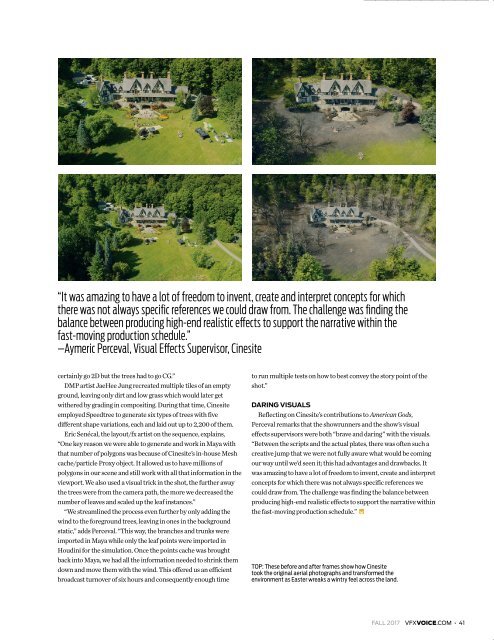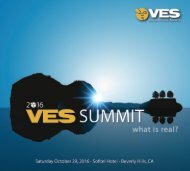Create successful ePaper yourself
Turn your PDF publications into a flip-book with our unique Google optimized e-Paper software.
“It was amazing to have a lot of freedom to invent, create and interpret concepts for which<br />
there was not always specific references we could draw from. The challenge was finding the<br />
balance between producing high-end realistic effects to support the narrative within the<br />
fast-moving production schedule.”<br />
—Aymeric Perceval, Visual Effects Supervisor, Cinesite<br />
certainly go 2D but the trees had to go CG.”<br />
DMP artist JaeHee Jung recreated multiple tiles of an empty<br />
ground, leaving only dirt and low grass which would later get<br />
withered by grading in compositing. During that time, Cinesite<br />
employed Speedtree to generate six types of trees with five<br />
different shape variations, each and laid out up to 2,200 of them.<br />
Eric Senécal, the layout/fx artist on the sequence, explains,<br />
“One key reason we were able to generate and work in Maya with<br />
that number of polygons was because of Cinesite’s in-house Mesh<br />
cache/particle Proxy object. It allowed us to have millions of<br />
polygons in our scene and still work with all that information in the<br />
viewport. We also used a visual trick in the shot, the further away<br />
the trees were from the camera path, the more we decreased the<br />
number of leaves and scaled up the leaf instances.”<br />
“We streamlined the process even further by only adding the<br />
wind to the foreground trees, leaving in ones in the background<br />
static,” adds Perceval. “This way, the branches and trunks were<br />
imported in Maya while only the leaf points were imported in<br />
Houdini for the simulation. Once the points cache was brought<br />
back into Maya, we had all the information needed to shrink them<br />
down and move them with the wind. This offered us an efficient<br />
broadcast turnover of six hours and consequently enough time<br />
to run multiple tests on how to best convey the story point of the<br />
shot.”<br />
DARING VISUALS<br />
Reflecting on Cinesite’s contributions to American Gods,<br />
Perceval remarks that the showrunners and the show’s visual<br />
effects supervisors were both “brave and daring” with the visuals.<br />
“Between the scripts and the actual plates, there was often such a<br />
creative jump that we were not fully aware what would be coming<br />
our way until we’d seen it; this had advantages and drawbacks. It<br />
was amazing to have a lot of freedom to invent, create and interpret<br />
concepts for which there was not always specific references we<br />
could draw from. The challenge was finding the balance between<br />
producing high-end realistic effects to support the narrative within<br />
the fast-moving production schedule.”<br />
TOP: These before and after frames show how Cinesite<br />
took the original aerial photographs and transformed the<br />
environment as Easter wreaks a wintry feel across the land.<br />
FALL <strong>2017</strong> <strong>VFX</strong>VOICE.COM • 41




